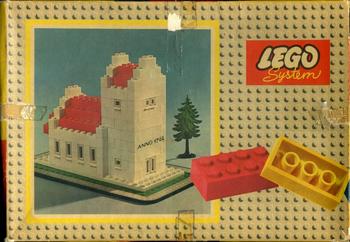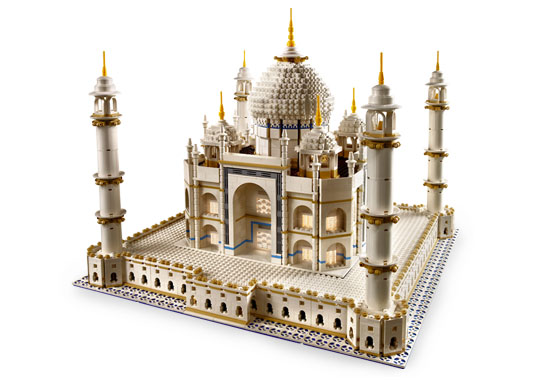It seems that LEGO has decided to steer clear of official sets touching on religious themes. I suppose this is because they are an international company seeking to sell to people from all different faith communities and do not wish to offend anyone. Personally I think that's sad - faith is such an important part of the human experience and has had such a prominent role in the development of societies that it seems a glaring lack in, say, their Town, Castle, and Wild West themes. This hasn't always been so. Back in 1957 and 1958 they released two sets, both called "church" or "kirche",
309 and
1309. These are pretty much the same set, except in one the printed brick says "1762" and in the other it says either "ANNO 1762" or "AD 1762". The construction is pretty simplistic and so these sets probably would not be of interest to the modern LEGO fan, except maybe for the square windows and old-style trees that haven't been produced in 30+ years. I can't find any significance to the year 1762. Does anyone have a clue to this? Maybe there is a prominent church in Denmark that was built in that year?

The one way that LEGO may get over their avoidance of religious themes is to go with architecturally significant landmarks that have huge cultural importance in addition to a religious sense. One such is the recent
Taj Mahal set.

While the Taj Mahal is not a temple or church, it is a mausoleum built for Mumtaz Mahal, the favorite wife of Mughal emperor Shah Jahan, in an Islamic tradition and, for instance, includes verses from the Koran as part of its decoration. Rituals and structures have been intimately linked to faith from tombs in ancient Egypt to European shrines to the saints. If LEGO can make the Taj Mahal a set due to it's architectural and cultural significance, surely they could do the same with something like Notre Dame. I should note that at the Legoland parks there are models of many such landmarks. I'll highlight some of those in future blog posts.


I'm not sure you can really equate the religious significance of the Taj Mahal and Notre Dame. The obvious comparison between an active Christian Cathedral and something from the Muslim religion would be a great Mosque, right? Of course, there is a mosque right immediately adjacent to the Taj Mahal, but that didn't make it into the LEGO model.
ReplyDeleteVery interesting to see the official LEGO church model, though, by the way. Seems to date from a time when LEGO was less concerned about what might be called "cultural sensitivity". Witness the red-skinned "Indians" from 1977 as well.
ReplyDeleteThis is not to say I don't fully support LEGO making models based on architecturally significant religious buildings, or even just generic churches, mosques, or temples for their town line. Whether they want to go further and make a Nativity Set or (enrage many believers) with a Muhammad playset set is up to them, too. I wouldn't necessarily be against it.
I see your point that the Taj Mahal has qualitative differences from Notre Dame. I was just trying to think what sets had religious references at all. I would love to see a continuation of the idea in the Taj Mahal set and make all kinds of world cultural landmarks at a similar scale. Basically the sorts of UNESCO World Heritage Sites that show up in that LEGO Piece of Peace display in Japan (a future blog post here), which include many with religious import.
ReplyDelete"Muhammad playset"
Well, they could just contract you to pull an image out of your illustrations of Judges. ;) Actually, that's another future blog post here where I was going to combine with other controversies at the interface of Islam and LEGO (backlash against Danish products after the political cartoons, the minor kerfuffle about LEGO Islamic Terrorists based on the BrickArms custom weapons).